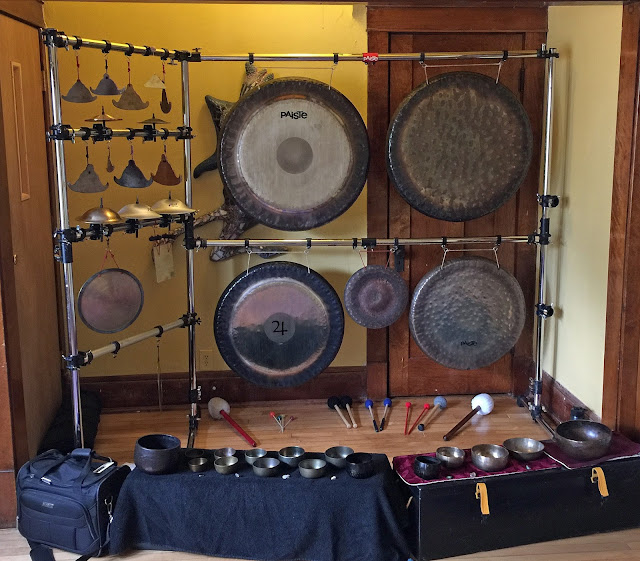Miking Your Gongs/Bells/Bowls In Larger Rooms - Part 1 of 3
Today's post comes from a suggestion by Mike Brother-Ong Tamburo in Pittsburgh, PA. Mike wanted me to write about miking Gongs in a larger room. That's a great subject, because it's also something with a lot of potential to help, or a lot of potential to go wrong.
I've played my instruments in very large rooms, concert halls, and outdoor settings where things have been miked with mixed results. Let's look at some problems first, and then some solutions.
The main problem I have found is most sound engineers (if you end up working with one) have absolutely no idea what to do when it comes to miking Gongs/Bowls/Bells. Most of them are more accustomed to miking up a drum set for a rock or country show, which is a completely different thing. If they try to approach things like they mic a drum set, or other percussion, then that usually spells trouble for the sound out front. Mind you, it's not completely their fault, because they have usually never encountered something like this.
I prefer to play in smaller places where I don't have to mic things up, and where I can have total control over what the sound is, but that's not always possible. So if I need to use a sound system, the first thing is to be friendly to the sound engineer. I then explain to them what I do, what my sound is all about, and how he can potentially capture that sound and present it to the audience.
You need to read up on miking instruments, microphones, and a bit on acoustics. You also need to know your instruments and their sounds well (see my last blog post). From there you can get an idea of how you want things to sound out front.
One thing you need to understand, and this is often the sound engineer's perspective, is that in miking drums for a rock/country concert, there may be a lot of processing going on to change the natural sound of the instruments. This is something we don't want to have happen when miking the Gongs/Bowls/Bells for either a meditation session, or a concert session. If you are lucky, the engineer will have some experience with classical music groups. If so, tell them it's a lot like miking a string quartet or string section: you just want to amplify things and also capture the air in the sound, so no close miking. One benefit is that since you are not in a rock band, your sound doesn't have to compete with any other really loud sounds.
Horror story #1:
Now on the other extreme, Success story #1:
Sound Tip #1:
OK, that's it for Part 1. In Part 2, we'll look at microphone types.
*I must say that I'm not a sound & recording expert, but I've done my homework. I've also paid attention and asked questions, both in the recording studio and live, of sound engineers. As for recording Gongs, I've collaborated with a lot of engineers figuring out how to get the best Gong/Bowl/Bell sound. Take these ideas as a start for your own explorations.
I've played my instruments in very large rooms, concert halls, and outdoor settings where things have been miked with mixed results. Let's look at some problems first, and then some solutions.
The main problem I have found is most sound engineers (if you end up working with one) have absolutely no idea what to do when it comes to miking Gongs/Bowls/Bells. Most of them are more accustomed to miking up a drum set for a rock or country show, which is a completely different thing. If they try to approach things like they mic a drum set, or other percussion, then that usually spells trouble for the sound out front. Mind you, it's not completely their fault, because they have usually never encountered something like this.
I prefer to play in smaller places where I don't have to mic things up, and where I can have total control over what the sound is, but that's not always possible. So if I need to use a sound system, the first thing is to be friendly to the sound engineer. I then explain to them what I do, what my sound is all about, and how he can potentially capture that sound and present it to the audience.
But before all this, you need to do your homework.
You need to read up on miking instruments, microphones, and a bit on acoustics. You also need to know your instruments and their sounds well (see my last blog post). From there you can get an idea of how you want things to sound out front.
One thing you need to understand, and this is often the sound engineer's perspective, is that in miking drums for a rock/country concert, there may be a lot of processing going on to change the natural sound of the instruments. This is something we don't want to have happen when miking the Gongs/Bowls/Bells for either a meditation session, or a concert session. If you are lucky, the engineer will have some experience with classical music groups. If so, tell them it's a lot like miking a string quartet or string section: you just want to amplify things and also capture the air in the sound, so no close miking. One benefit is that since you are not in a rock band, your sound doesn't have to compete with any other really loud sounds.
Horror story #1:
I was playing a concert in a rather large club (headlining a 3 act bill). They had a nice sound system and a house sound engineer, who was an older guy and sounded like he was experienced in running sound. Things were rushed and there was no time for a sound check, but I chatted with him for a minute and he seemed to know his stuff. I listened some to the opening act, an improv group with horns, strings, drums, and they sounded fine. So I played the concert not being able to hear what it sounded like out front. Afterwards, the sound guy was like, "That was great. It sounded really cool out here. I had some echo going and was panning things back and forth." My first reaction was, "Yikes! What did it sound like?"
Now on the other extreme, Success story #1:
Because the instruments I use are so unusual in most of these situations, I have had many sound guys ask me, "What do I have to do?" They are at a loss and look to me for some sort of expertise on how to mic up things and get a good sound—this is where doing your homework and learning about mics and sound is important.
Sound Tip #1:
If I have the time, whether all acoustic or miked, I like to play the Gongs and then walk around the room listening to them. I'm listening to the acoustics of the room, how loud things sound in different areas of the room, if there is a dominant/resonant frequency that stands out, and just getting a general feel for the room. I like to know what's going to happen and how things will sound out front. Granted, I have to take into account that a room full of people and blankets will change the acoustic properties some, but I still want to get a feel for the room and how it sounds out front. Sometimes you will have a hot frequency and one Gong will seem predominantly louder than the others, you want to remember to tone it down a bit. Or the opposite can happen, where one Gong's sound get's lost, so you need to bring it out more. Again, do your homework so you know your sounds!
OK, that's it for Part 1. In Part 2, we'll look at microphone types.
~ MB
Chop Wood | Carry Water | Play Gongs



Comments
Post a Comment